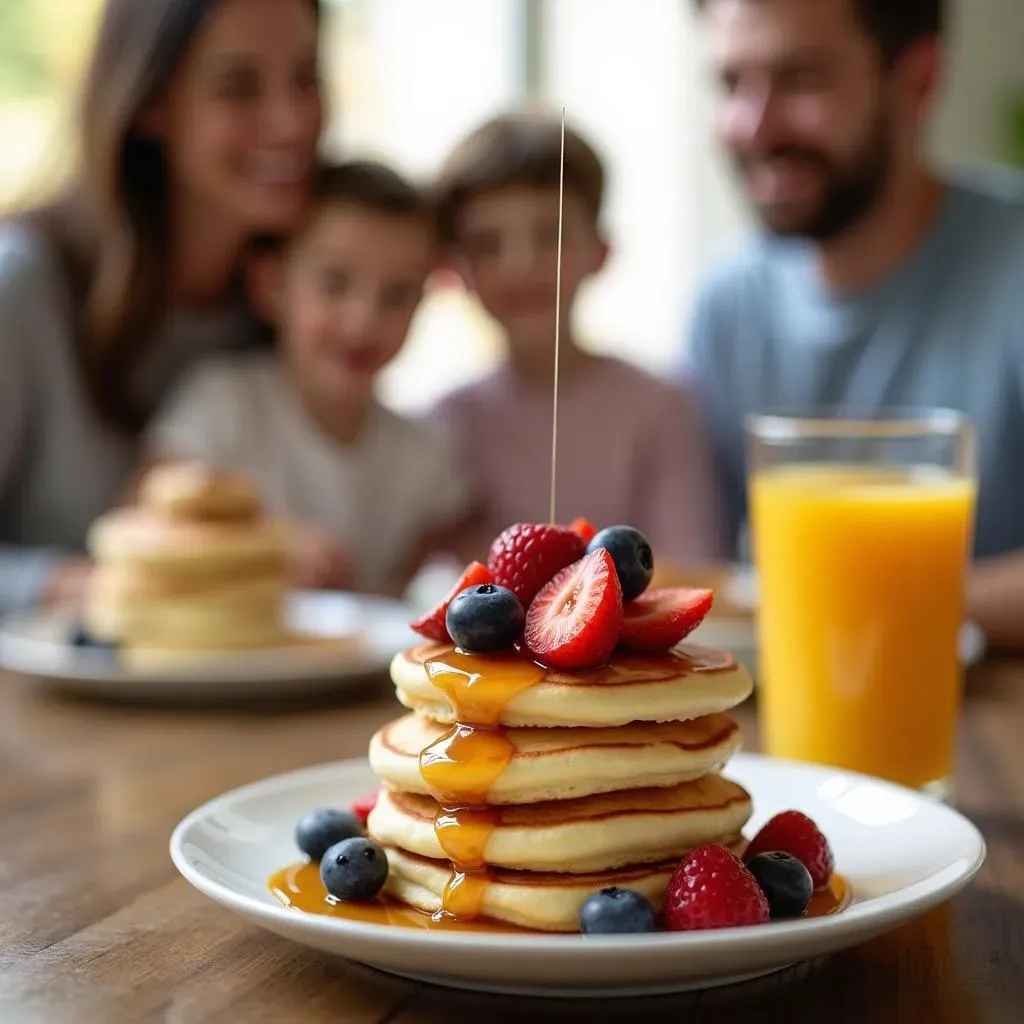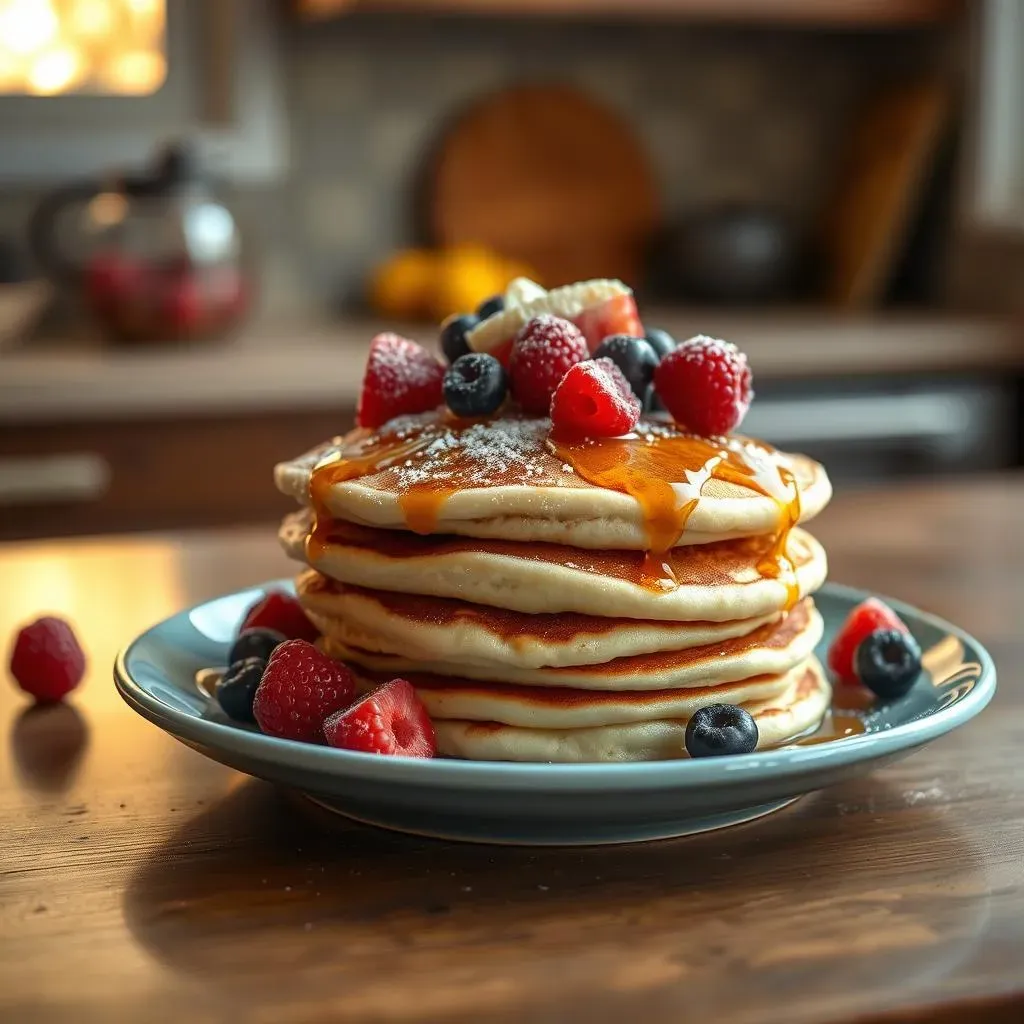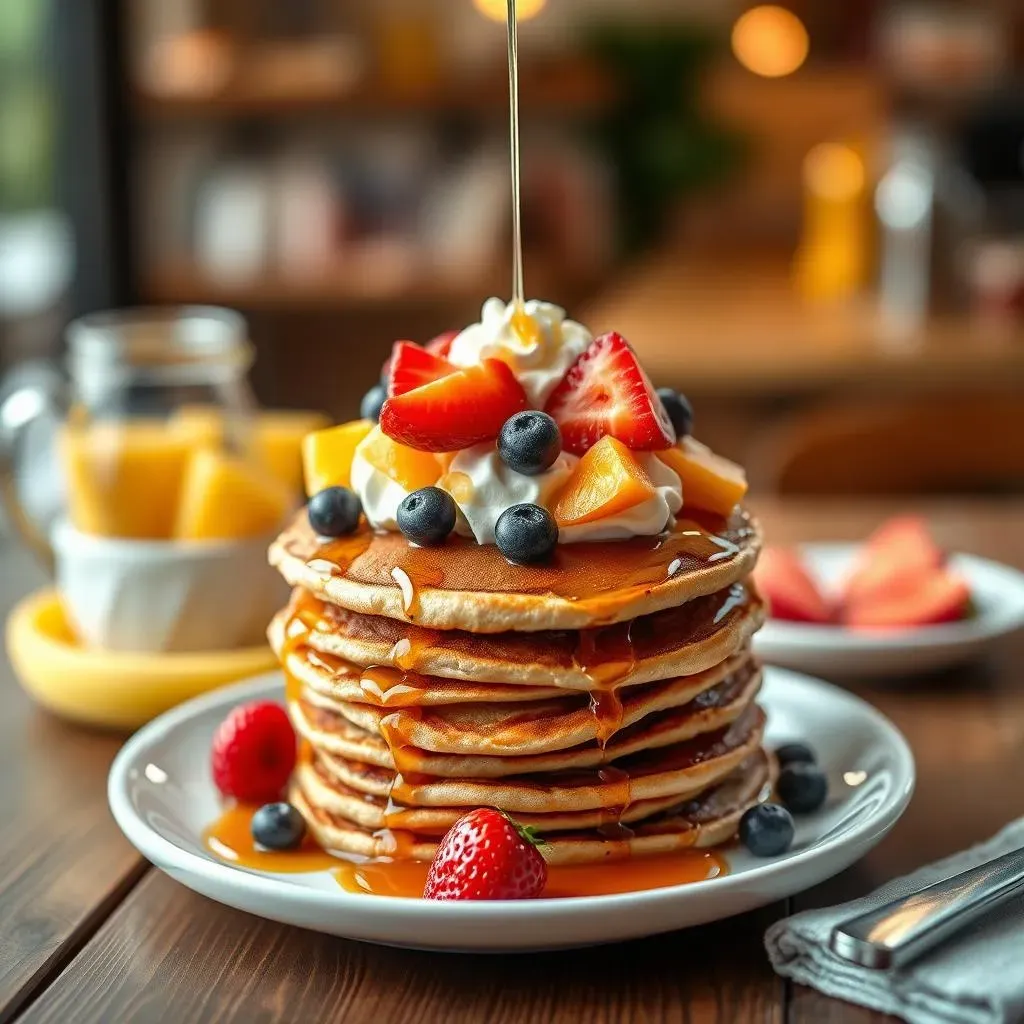Table of Contents
Pancakes! Just the word conjures up images of fluffy, golden goodness, a weekend breakfast staple. But what if your little one has a gluten intolerance? Don't despair! This article is your guide to creating the perfect gluten-free pancake recipe for kids, ensuring everyone gets a delicious and safe breakfast. We'll explore why going gluten-free might be necessary, then dive straight into an incredibly simple recipe that even your kids can help with. We'll tackle those pesky gluten-free pancake problems – the gummy middles, the crumbly edges – and offer solutions to make your pancakes consistently fluffy and delicious. Finally, we’ll unleash your creativity with fun variations and topping ideas that will transform your pancakes from a simple breakfast into a culinary adventure your kids will adore. Get ready to flip your way to pancake perfection with our ultimate gluten-free pancake recipe for kids!
Why GlutenFree Pancakes? Understanding the Need

Why GlutenFree Pancakes? Understanding the Need
Celiac Disease and Gluten Intolerance
Let's talk about gluten. It's a protein found in wheat, barley, and rye. For some kids, gluten isn't just a bit of a tummy ache; it's a serious problem. Celiac disease is an autoimmune disorder where eating gluten damages the small intestine. This can lead to all sorts of issues, from weight loss and fatigue to severe stomach pain and even developmental delays. A gluten-free diet is essential for these kids, and that means saying goodbye to regular pancakes (at least, the regular kind!). Making delicious gluten-free alternatives is key to ensuring they don't miss out on breakfast fun.
Think of it like this: imagine your body's intestines are a superhighway. Gluten acts like a huge pothole, blocking traffic and causing a major backup. A gluten-free diet repairs that pothole, allowing everything to flow smoothly again. For kids with celiac disease, it's not a choice; it's a necessity for their health and well-being. Learning how to make tasty gluten-free pancakes is part of ensuring they thrive.
Non-Celiac Gluten Sensitivity: A Common Issue
Even if your child doesn't have celiac disease, they might still be sensitive to gluten. Non-celiac gluten sensitivity (NCGS) is a pretty common condition where people experience symptoms like bloating, gas, diarrhea, or headaches after eating gluten. While not as severe as celiac disease, these symptoms can still make a child uncomfortable and unhappy. Switching to a gluten-free diet can significantly improve their quality of life, and delicious gluten-free pancakes can be a welcome part of the change. It's all about finding what works best for your child.
- Bloating
- Gas
- Diarrhea
- Headaches
Sometimes, it's trial and error to figure out if gluten is the culprit. If your child frequently experiences these symptoms after eating wheat-based products, it's worth considering trying a gluten-free diet, under the guidance of a doctor or dietitian, of course. A simple way to start is by replacing regular pancakes with our delicious gluten-free pancake recipe for kids.
Wheat Allergies: A Different Kind of Sensitivity
A wheat allergy is different from celiac disease or NCGS. It's an immune system reaction to wheat proteins, which can cause symptoms ranging from mild skin rashes to life-threatening anaphylaxis. If your child has a wheat allergy, avoiding all wheat products, including regular pancakes, is crucial to their safety. Gluten-free pancakes made with alternative flours like almond flour (almond flour pancakes recipe) or oat flour (oat flour pancakes) are a safe and delicious alternative. Always read labels carefully to ensure that products are certified gluten-free and wheat-free.
Remember, consulting with a doctor or allergist is essential when dealing with allergies. They can provide personalized advice and guidance on managing your child's dietary needs. Our dairy-free and gluten-free pancake recipe is a fantastic starting point for those with multiple allergies.
The Easiest GlutenFree Pancake Recipe Ever

The Easiest GlutenFree Pancake Recipe Ever
The Simple Recipe
Okay, let's get down to business. This recipe is so easy, it's almost cheating! You'll need a gluten-free flour blend (I like Bob's Red Mill 1-to-1 Baking Flour, but any good quality blend will work), some sugar (granulated or coconut), baking powder, salt, milk (dairy or non-dairy – almond or oat milk are great!), and eggs (or a flax egg substitute for vegan pancakes). That's it! No fancy ingredients, no complicated steps. Just simple, wholesome goodness. For a richer flavor, try adding a touch of vanilla extract. You can find more tips on choosing the best flour blend in our best gluten-free pancake mix guide.
Mix all the dry ingredients together in a bowl. In a separate bowl, whisk together the wet ingredients. Then, gently pour the wet ingredients into the dry ingredients and whisk until just combined – don't overmix! Overmixing develops gluten (even in gluten-free flour) and can make your pancakes tough. A few lumps are perfectly fine. Let the batter rest for about 5 minutes; this helps the baking powder activate and makes for fluffier pancakes. Heat a lightly oiled griddle or pan over medium heat, and pour ¼ cup of batter onto the hot surface for each pancake. Cook for 2-3 minutes per side, or until golden brown and cooked through.
- 1 cup gluten-free flour blend
- 2 tbsp sugar
- 2 tsp baking powder
- ½ tsp salt
- 1 cup milk (dairy or non-dairy)
- 1 egg (or flax egg)
See? Told you it was easy! This basic recipe is incredibly versatile. Want banana pancakes? Mash a ripe banana into the batter! Craving chocolate chip pancakes? Stir in some chocolate chips! The possibilities are endless. For more inspiration, check out our banana pancake recipe or our guide on gluten-free pancake toppings.
One thing I like to do is make a double batch and freeze some for later. Freezing pancakes is simple. Just let them cool completely and then stack them between sheets of parchment paper in a freezer bag. They’ll last for up to 3 months. Reheating is also a breeze - just pop them in the toaster or microwave for a quick and easy breakfast. Learn more about storing and reheating gluten-free pancakes for future convenience.
Ingredient | Amount |
|---|---|
Gluten-free flour blend | 1 cup |
Sugar | 2 tbsp |
Baking powder | 2 tsp |
Salt | ½ tsp |
Milk | 1 cup |
Egg | 1 |
Troubleshooting: Fixing Common GlutenFree Pancake Problems

Troubleshooting: Fixing Common GlutenFree Pancake Problems
The Gummy Middle Mystery
Ah, the dreaded gummy middle! It's a common complaint with gluten-free pancakes, and it usually boils down to one thing: too much moisture. Gluten-free flours absorb liquid differently than wheat flour. If your pancakes are gummy, try reducing the amount of milk in your recipe slightly. Start by decreasing it by a tablespoon or two and see if that helps. You might also need to adjust your cooking time and temperature. Cook the pancakes over medium-low heat to ensure they cook through evenly without burning the outside before the inside is done. Check out our tips for making perfect gluten-free pancakes for more detailed guidance.
Another culprit could be the type of gluten-free flour blend you're using. Some blends are more absorbent than others. If you're consistently getting gummy pancakes, experiment with different blends to see which one works best for you. Our gluten-free pancake mix comparison article can help you choose the right one for your needs. Remember, even with the best flour, if you overmix the batter, you'll likely end up with tough, gummy pancakes.
- Reduce milk by 1-2 tablespoons
- Cook over medium-low heat
- Try a different gluten-free flour blend
- Avoid overmixing the batter
Crumbly Edges and Dry Pancakes
On the other hand, if your gluten-free pancakes are coming out dry and crumbly, you might need to add a bit more moisture. Try adding a tablespoon or two of milk or even a little bit of melted dairy-free butter or oil to the batter. You can also experiment with adding a little extra liquid to your batter, like applesauce or mashed banana, to add moisture and sweetness. These additions not only add moisture but also enhance the flavor and texture of your pancakes. For extra deliciousness, try our banana pancake recipe.
Another reason for dry pancakes could be an old or improperly stored baking powder. Baking powder is what makes your pancakes rise, and if it's past its prime, it won't do its job effectively. Check the expiration date on your baking powder and replace it if needed. Alternatively, if you’re aiming for a healthier option, you can try making pancakes without baking powder; our recipe without baking powder is a good place to start. Remember, fresh ingredients are key to success in baking!
Problem | Possible Solution |
|---|---|
Gummy Pancakes | Reduce liquid, lower heat, different flour blend |
Dry Pancakes | Add more liquid, check baking powder, use fresh ingredients |
Fun Variations and Delicious Toppings for KidApproved Pancakes

Fun Variations and Delicious Toppings for KidApproved Pancakes
Pancake Makeovers: Beyond the Basic Batter
Let's face it: plain pancakes can get boring, even for adults! But with gluten-free pancakes, the possibilities are endless. Think of your basic recipe as a blank canvas, ready for a burst of creativity. Want to add some fruity fun? Mix in blueberries, raspberries, or chopped bananas directly into the batter for a delightful surprise in every bite. Love chocolate? Chocolate chips are a classic for a reason! For a fun twist, consider using mini chocolate chips for extra visual appeal. Or, try adding cocoa powder to the batter itself for a richer chocolate flavor. Feeling adventurous? Try adding some finely grated zucchini or carrots for a sneaky dose of extra veggies. The kids might not even notice!
For extra flavor, consider adding spices like cinnamon, nutmeg, or even a pinch of cardamom. These warm spices complement the sweetness of the pancakes perfectly, adding a sophisticated touch without being overpowering. You can also experiment with extracts like vanilla, almond, or even lemon for a fresh, zesty flavor. Don't be afraid to get creative! The goal is to make pancake-making a fun and engaging experience for your kids, turning breakfast into a collaborative culinary project. Check out our banana pancake recipe for a naturally sweet and delicious variation.
- Blueberries
- Raspberries
- Chocolate chips
- Cocoa powder
- Zucchini
- Cinnamon
- Vanilla extract
Topping It Off: The Sweetest Part of the Pancake Experience
Now for the fun part: the toppings! This is where you can really let your imagination run wild. Classic maple syrup is always a winner, but don't limit yourself. Try different kinds of syrups like honey, agave, or even flavored syrups like strawberry or blueberry. Whipped cream, fresh fruit (berries, sliced bananas, peaches), and a sprinkle of powdered sugar are all excellent choices. For a little extra protein and healthy fats, top your pancakes with a dollop of nut butter (peanut butter, almond butter) or a sprinkle of chopped nuts. You can even get creative with yogurt – plain Greek yogurt or a flavored option can add a creamy, tangy element to your pancakes.
Remember, presentation matters! Arrange the toppings artfully on the pancakes to make them visually appealing to your kids. A little bit of creativity can go a long way in making breakfast a more enjoyable experience. Consider making a pancake bar where your kids can choose their own toppings and create their own personalized pancake masterpieces. This is a great way to get them involved in the process and encourage them to try new things. To find even more topping ideas, check out our gluten-free pancake toppings guide. And don't forget the fun factor! Use cookie cutters to make fun shapes out of your pancakes. Add sprinkles, edible glitter, or even make faces out of your toppings.
Topping Category | Topping Ideas |
|---|---|
Syrups | Maple syrup, honey, agave, flavored syrups |
Fruits | Berries, bananas, peaches, apples |
Dairy/Alternatives | Whipped cream, yogurt |
Nuts/Seeds | Chopped nuts, nut butter, seeds |